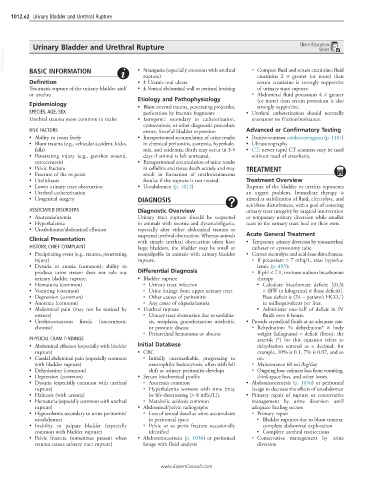Page 2025 - Cote clinical veterinary advisor dogs and cats 4th
P. 2025
1012.e2 Urinary Bladder and Urethral Rupture
Urinary Bladder and Urethral Rupture Client Education
Sheet
VetBooks.ir
• Stranguria (especially common with urethral
BASIC INFORMATION
creatinine 2 × greater (or more) than
rupture) ○ Compare fluid and serum creatinine; fluid
Definition • ± Uremic oral ulcers serum creatinine is strongly supportive
Traumatic rupture of the urinary bladder and/ • ± Ventral abdominal wall or perineal bruising of urinary tract rupture.
or urethra ○ Abdominal fluid potassium 4 × greater
Etiology and Pathophysiology (or more) than serum potassium is also
Epidemiology • Blunt external trauma, penetrating projectiles, strongly supportive.
SPECIES, AGE, SEX perforation by fracture fragments • Urethral catheterization should normally
Urethral trauma more common in males • Iatrogenic: secondary to catheterization, encounter no friction/resistance.
cystocentesis, or other diagnostic procedure
RISK FACTORS errors; forceful bladder expression Advanced or Confirmatory Testing
• Ability to roam freely • Intraperitoneal accumulation of urine results • Positive-contrast urethrocystogram (p. 1181)
• Blunt trauma (e.g., vehicular accident, kicks, in chemical peritonitis, azotemia, hyperkale- • Ultrasonography
falls) mia, and acidemia; death may occur in 3-5 • CT; newer rapid CT scanners may be used
• Penetrating injury (e.g., gunshot wound, days if animal is left untreated. without need of anesthesia.
cystocentesis) • Extraperitoneal accumulation of urine results
• Pelvic fracture in cellulitis and tissue death acutely and may TREATMENT
• Fracture of the os penis result in formation of urethrocutaneous
• Urolithiasis fistulas if the rupture is not treated. Treatment Overview
• Lower urinary tract obstruction • Uroabdomen (p. 1012) Rupture of the bladder or urethra represents
• Urethral catheterization an urgent problem. Immediate therapy is
• Urogenital surgery DIAGNOSIS aimed at stabilization of fluid, electrolyte, and
acid-base disturbances, with a goal of restoring
ASSOCIATED DISORDERS Diagnostic Overview urinary tract integrity by surgical intervention
• Azotemia/uremia Urinary tract rupture should be suspected or temporary urinary diversion while smaller
• Hyperkalemia in animals with uremia and dysuria/oliguria, tears in the urinary tract heal on their own.
• Uroabdomen/abdominal effusion especially after either abdominal trauma or
suspected urethral obstruction. Whereas animals Acute General Treatment
Clinical Presentation with simple urethral obstruction often have • Temporary urinary diversion by transurethral
HISTORY, CHIEF COMPLAINT large bladders, the bladder may be small or catheter or cystostomy tube
• Precipitating event (e.g., trauma, penetrating nonpalpable in animals with urinary bladder • Correct electrolyte and acid-base disturbances.
injury) rupture. ○ If potassium > 7 mEq/L, treat hyperka-
• Dysuria or anuria (common); ability to lemia (p. 495):
produce urine stream does not rule out Differential Diagnosis ○ If pH < 7.1, institute sodium bicarbonate
urinary bladder rupture. • Bladder rupture therapy
• Hematuria (common) ○ Urinary tract infection ■ Calculate bicarbonate deficit: [(0.3)
• Vomiting (common) ○ Urine leakage from upper urinary tract × (BW in kilograms) × (base deficit)].
−
• Depression (common) ○ Other causes of peritonitis Base deficit is (24 − patient’s HCO 3 )
• Anorexia (common) ○ Any cause of oliguria/anuria in milliequivalents per liter.
• Abdominal pain (may not be noticed by • Urethral rupture ■ Administer one-half of deficit in IV
owners) ○ Urinary tract obstruction due to urolithia- fluids over 6 hours.
• Urethrocutaneous fistula (uncommon; sis, neoplasia, granulomatous urethritis, • Provide crystalloid fluids at an adequate rate.
chronic) or prostatic disease ○ Rehydration: % dehydration* × body
○ Periurethral hematoma or abscess weight (kilograms) = deficit (liters); the
PHYSICAL EXAM FINDINGS asterisk (*) for this equation refers to
• Abdominal effusion (especially with bladder Initial Database dehydration entered as a decimal; for
rupture) • CBC example, 10% is 0.1, 7% is 0.07, and so
• Caudal abdominal pain (especially common ○ Initially unremarkable, progressing to on.
with bladder rupture) neutrophilic leukocytosis, often with left ○ Maintenance 60 mL/kg/day
• Dehydration (common) shift as urinary peritonitis develops ○ Ongoing loss: estimate loss from vomiting,
• Depression (common) • Serum biochemical profile third-space loss, and other losses.
• Dysuria (especially common with urethral ○ Azotemia common • Abdominocentesis (p. 1056) or peritoneal
rupture) ○ Hyperkalemia worsens with time (may lavage to decrease the effects of uroabdomen
• Halitosis (with uremia) be life-threatening [> 8 mEq/L]). • Primary repair of rupture or conservative
• Hematuria (especially common with urethral ○ Metabolic acidosis common management by urine diversion until
rupture) • Abdominal/pelvic radiographs adequate healing occurs
• Hypovolemia secondary to urine peritonitis/ ○ Loss of serosal detail as urine accumulates ○ Primary repair
uroabdomen in peritoneal space ■ Bladder ruptures due to blunt trauma:
• Inability to palpate bladder (especially ○ Pelvic or os penis fracture occasionally complete abdominal exploration
common with bladder rupture) identified ■ Complete urethral transections
• Pelvic fracture (sometimes present when • Abdominocentesis (p. 1056) or peritoneal ○ Conservative management by urine
trauma causes urinary tract rupture) lavage with fluid analysis diversion
www.ExpertConsult.com

